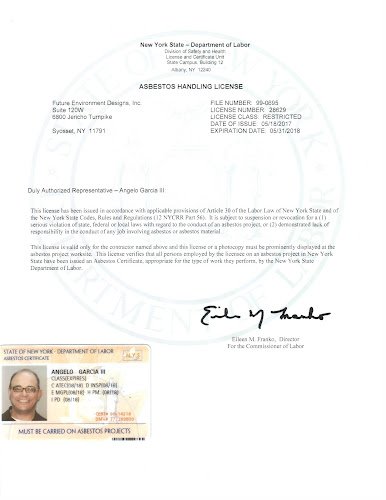When we first became an asbestos consultant over 39 years ago, we remember people telling us that buildings will remove all their
asbestos materials in 5 years, 10 years, or 15 years depending on who we talked to. Well, asbestos is still in
buildings and this article is about why there are many years still left in this industry. In the construction industry, there are some who think that a certain
year was the end of asbestos use in building materials. Over the years we have reviewed many asbestos
inspection reports or property transfer reports (phase I environmental audits)
reporting that since a building or a part of a building was built after 1980
there are no asbestos-containing materials.
The companies making this statement assume that the federal government
banned all asbestos-containing materials in 1980. In New
York State,
the Department of Labor (NYSDOL), which regulates asbestos abatement, uses the year
1974 in the regulations for determining which buildings require the assumption of building materials that contain asbestos. While the federal
government, under the Occupational Safety and Health Administration (OSHA)
regulation 1926.1101 (k) (1), requires building owners to presume surfacing materials, and thermal system insulations, installed prior to 1980, to contain asbestos. To refute this presumption these materials must be sampled. Regarding asphalt and vinyl flooring materials installed no later than 1980 must also be considered asbestos-containing or sampled to refute the designation. In addition, the regulation also requires if the employers/building owners have actual knowledge, or should have known through the exercise of due diligence, that other materials are asbestos-containing they too must be treated as such. Owners are required to handle these building
materials as asbestos-containing materials (ACM) until a certified asbestos
inspector takes samples of the materials, in accordance with the Environmental
Protection Agency's (EPA's) Asbestos Hazard Emergency Response Act (AHERA), and the
samples verify the materials do not contain asbestos (which usually means multiple samples of the building material have to been taken and all samples must have results that no asbestos is in the building material). However, are 1974 or 1980 appropriate
dates to use in making a determination whether building materials can contain
asbestos? We think not!
 |
| Terrazo? |
The Ban and
Attempts to Ban Asbestos
The federal agency with
the responsibility for banning asbestos is the EPA. This agency, under the National
Emissions Standards for Hazardous Air Pollutants (NESHAPS), banned the use of
asbestos for sprayed-on application of fireproofing and insulating in 1973 and
for decorating purposes in 1978. In 1975 EPA’s NESHAPS regulation
also banned the installation of pre-formed (molded) asbestos block insulation
on boilers and hot water tanks and the wet-applied and pre-formed (molded)
asbestos pipe insulation. Since two of
these bans did not go into effect until after 1974, the New York State
end of use date is not appropriate and the construction industry should not use
it to determine buildings that contain asbestos. In 1985 EPA published "Guidance for Controlling Asbestos-Containing Materials in Buildings" which has become known as the "Purple Book". The Purple Book in Appendix A has a list titled "Asbestos-Containing Materials in Buildings". This list shows a large number of asbestos-containing materials that were still being used in 1981. Based on this information, it seems 1980 is not an appropriate end date for asbestos use, including asphalt and vinyl flooring materials. Under a separate regulation, the Toxic
Substances Control Act (TSCA), EPA tried to ban and phase out the use of
asbestos in 1989. In 1991 the “Asbestos
Ban and Phaseout Rule,” as the rule became known as, was vacated and remanded
by the U.S. Fifth Circuit Court of Appeals.
In 1993 EPA stated that corrugated paper, roll board, commercial paper,
specialty paper, flooring felt, and new uses of asbestos were still subject to
the ban. Vacating the “Asbestos Ban and Phaseout Rule”
meant that a number of building materials could contain asbestos such as asbestos-cement corrugated sheet, asbestos-cement flat sheet, asbestos
clothing, pipeline wrap, roofing felt, vinyl-asbestos floor tile,
asbestos-cement shingle, millboard, asbestos-cement pipe, automatic
transmission components, clutch facings, friction materials, disc brake pads,
drum brake linings, brake blocks, gaskets, ceiling tiles, non-roofing coatings, and roof
coatings are not banned and could still be used in buildings. The recent attempt to ban asbestos was made under the amended TSCA regulation. In 2016, President Barak Obama signed the Frank R. Lautenberg Chemical Safety for the 21st Century Act that amended TSCA and made needed improvements to the law including requiring risk-based chemical assessments. In 2019 EPA published a final rule called the Significant New Use Rule (SNUR). The SNUR requires manufacturers and importers to receive EPA approval before starting or resuming manufacturing and importing or processing of asbestos. Materials subject to this law include adhesives; sealants; roof coatings; arc chutes; beater-add gaskets; extruded sealant tape; and other tapes; filler for acetylene cylinders; high-grade electrical paper; billboard; missile liner; packings; pipeline wrap; reinforced plastics; roofing felt; separators in fuel cells and batteries; vinyl-asbestos floor tile; cement products; woven products; and any other building material. It is obvious that this law does not ban asbestos nor does it really answer the question of how much asbestos is in commerce currently.
 |
| Electrical wire insulation |
Asbestos Used Still Today
Is there an appropriate
end date for asbestos use in buildings? Some headlines indicate the answer to this question is no. These headlines indicate that some current building
materials are contaminated with asbestos or still contain asbestos sufficiently
enough for the materials to be considered asbestos-containing materials. For example, the Asbestos Disease Awareness
Organization (ADAO) reported in November 2007 that they sampled a number of current
building materials and determined that DAP’s “33” window glazing and “crack
shot” spackling paste and Gardner’s leak stopper roof patch all contained
asbestos. DAP’s “33” window glazing was
purchased at Home Depot and Lowes for the purpose of the study and contained 2.6%
tremolite, and 0.13% chrysotile asbestos (2.73% total asbestos). DAP’s “crack shot” spackling paste was also purchased
at Home Depot and Lowes and contained 0.98% tremolite, and 0.066% chrysotile
asbestos (1.05% total asbestos). Gardner’s “leak stopper roof patch,” along with other
products by Gardner,
is listed with the National Institute of Health as known asbestos-containing
material on the open market and contained 11% chrysotile asbestos. It is important to remember that the definition of asbestos-containing materials is any material that contains greater than 1% of asbestos in the material. Though this does not apply to the OSHA asbestos regulation which is more concerned about how much asbestos gets in the air from a material that contains any asbestos. In addition, the New York Times reported on
July 20, 2001, that W. R. Grace & Company’s Monokote (probably #5) fireproofing spray
product (used in the late 1980s) was contaminated with tremolite
asbestos. The Seattle Post-Intelligencer
reported on February 8, 2005, that seven of W. R. Grace & Company’s current
or former executives were indicted on federal charges that they knowingly put
their workers and the public in danger through exposure to vermiculite ore
contaminated with tremolite asbestos from its mine in Libby, Montana. In 1990 W. R. Grace & Company closed the
mine but the ore was used as attic and wall insulation, wallboard, and
fireproofing into the early 1990s. The
asbestos content in these materials can be as high as 2%. In research conducted by EPA on vermiculite
attic insulation in 2001 and 2002, found homeowners that use their attics could
be exposed to airborne asbestos fibers above the OSHA permissible exposure limit (0.1 fibers/cubic centimeters).
 |
| asbestos woven products |
The
Liability of Ignorance
Since there is no total ban on the use of asbestos
in building materials, it means that 1974 or 1980 are not appropriate cut off
dates on the use of asbestos in building materials. This means all buildings or facilities no matter when they were constructed should be inspected for asbestos-containing materials. EPA's NESHAP regulation 40 CFR 61.145 Standard for demolition and renovation requires buildings/facilities to be thoroughly inspected before the renovation or demolition, no matter what date the building was built. It also means that the construction industry
should be very careful when working on buildings after these dates because it
is possible that if an asbestos inspection or survey was done it may have not been done properly. From our experience, we've seen inspectors not sample roofing materials, joint compound, sheetrock, textured paint, siding shingles, and window caulking just to name a few building materials that should be sampled. Building owners,
banks, facility managers, architects, engineers, general contractors, and
subcontractors should not think that because the EPA regulation requires an inspection, and if the inspection is not done correctly that there is no chance for a violation or liability. OSHA requires that employers inform their
workers of all the potential hazards at a project (job) site. Should materials that were not inspected turn
out to be asbestos-containing or even if the sample result is 1% or trace asbestos and the exposure exceeds the permissible exposure
limit (0.1 fibers per cubic centimeter based on an eight hour time-weighted
average) or the excursion limit (1.0 fibers per cubic centimeter over thirty
minutes) the employer would be in violation of the OSHA asbestos
regulation. No matter the construction
date of the building. The building owner
could then face third-party litigation from the workers if they develop a
disease (mesothelioma being the most significant because of its direct tie to
asbestos exposure) from such an exposure. In addition, the AHERA regulation which
applies to public and private schools (kindergarten to 12th grade) requires that architects that design new
schools or renovations of existing schools certify that the building materials
used do not contain asbestos. Utilizing safety data sheets (SDS), which are required for most building
products, to certify the products would not be sufficient considering that
DAP’s SDS (discussed above) did not mention the asbestos contamination in the product and the NESHAPS regulation requires building materials to be sampled for the content of asbestos. Meaning the only way to certify the products
to limit liability would be to have suspected materials sampled and analyzed
for asbestos. It is very important for
building owners, banks, facility managers, architects, engineers, general
contractors, sub-contractors, asbestos inspectors, and phase I environmental
auditors to realize that although the asbestos regulations refer to dates before 1980, inspections are advisable and required under the EPA's NESHAPS & OSHA's asbestos regulations since the
installation of asbestos-containing materials into buildings can continue to this
day.
 |
| Fire Door |







































